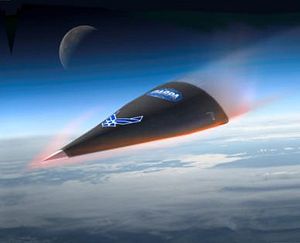Last Wednesday, China conducted its fifth test of the WU-14 hypersonic glide vehicle (HGV) – an ultra high-speed missile purportedly capable of penetrating U.S. air defense systems based on interceptor missiles, Bill Gertz of The Washington Free Beacon reports.
“The latest test of what the Pentagon calls the Wu-14 hypersonic glide vehicle was carried out from the Wuzhai missile test range in central China. The test was judged successful, according to defense officials familiar with details of the event,” Gertz notes.
This was the fifth time that China tested this new weapon (See: “Will This Chinese Weapon Be Able to Sink an Aircraft Carrier?”) and it could be an indication that the W-14 may soon become operational.
Similar to the June 7 test, the WU-14 HGV again performed evasive actions – extreme maneuvers – which makes the detection and tracking of the weapon difficult, if not impossible.
As I noted in my previous piece, the W-14 warhead is carried to the boundary between space and Earth’s atmosphere, approximately 100 km above the ground, by a large ballistic missile booster. Once it reaches that height, it begins to glide in a relatively flat trajectory by executing a pull-up maneuver and accelerates to speeds of up to Mach 10.
The gliding phase enables the W-14 HGV not only to maneuver aerodynamically – performing evasive actions and evading interception – but also extends the range of the missile.
Furthermore, I explained:
[U]nlike conventional reentry vehicles, which descend through the atmosphere on a predictable ballistic trajectory, hypersonic glider vehicles are almost impossible to intercept by conventional missile defense systems, which track incoming objects via satellite sensors and ground and sea radar.
Thus, the answer to why the Pentagon should be worried about this new weapon is simple: its speed, range, and erratic flight path make it a potent weapon that not only could be deployed against land targets but also used to attack large U.S. naval vessels, although the development of such an anti-ship HGV could still take up to two decades, according to experts.
However, Rick Fisher, a senior fellow with the International Assessment and Strategy Center told the Washington Free Beacon that the threat against U.S. naval assets could indeed become a reality in the future:
At a minimum this latest test indicates China is likely succeeding in achieving a key design objective: building a warhead capable of withstanding the very high stress of hypersonic maneuvering. It is likely that the test vehicle will form the basis for a missile launched weapon. The advent of a Chinese hypersonic weapon may pose the greatest early threat to large U.S. Navy ships. The best prospect for a defensive response would be to greatly accelerate railgun development.
Unfortunately, the U.S. Navy has had a number of difficulties fielding directed energy weapons systems such as railguns for a while now (See: “US Navy’s Deadly New Gun Won’t Be Ready for Some Time”).
On August 6, China also tested its newest intercontinental ballistic missile (ICBM) – the DF-41 (CSS-X-20) – with two guided simulated nuclear warheads (See: “China Tests New Missile Capable of Hitting Entire United States”). WU-14 hypersonic glider vehicles (HGVs) could potentially be installed on the DF-41, which would provide Beijing for the first time with a precision strike capability to hit any target in the world within an hour.

































